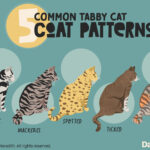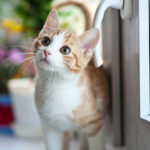Domestic cats are beloved companions in millions of homes worldwide, and their diversity is truly remarkable. From sleek Siamese to fluffy Persians, the world of house cats encompasses a wide array of breeds, each with unique physical characteristics and temperaments. But what truly defines the “types” of house cats we know and love? Delving into the science behind their classification and understanding the different ways we categorize them reveals a fascinating story of evolution, domestication, and individual personalities.
While often referred to as different “species” in casual conversation, scientifically, all domestic house cats belong to the same species, Felis catus. However, recent genetic research has further refined this, placing the domestic cat as a subspecies of the wildcat, specifically Felis silvestris catus. This classification highlights their close evolutionary relationship to wildcats, particularly Felis silvestris lybica, the Near Eastern wildcat.
Studies analyzing mitochondrial DNA (mtDNA) have provided compelling evidence for this subspecies designation. These studies reveal that domestic cats share a common maternal lineage with Felis silvestris lybica, indicating that domestication originated from this specific wildcat subspecies in the Near East. Interestingly, domestic cats exhibit no reduction in genetic diversity compared to their wild counterparts. This suggests that cat domestication wasn’t a result of a single, limited founding population, but rather involved multiple wildcat lines contributing to the domestic cat gene pool. Genetic analyses have identified at least five distinct wildcat lineages from the Near East (designated A through E) that contributed to the ancestry of modern domestic cats.
This understanding of domestic cats as Felis silvestris catus emphasizes their close ties to wildcats and highlights the relatively recent nature of their domestication. It also underscores that despite the vast differences in appearance and behavior we see across various cat breeds, they are all fundamentally part of the same subspecies.
Beyond the scientific classification, “Types Of House Cats” can be understood in several practical and engaging ways:
Cat Breeds: A Spectrum of Physical Traits
Perhaps the most common way to categorize house cats is by breed. Centuries of selective breeding have resulted in a stunning array of cat breeds, each with distinct physical characteristics. From the long, flowing coats of Persian and Maine Coon cats to the short, patterned fur of Siamese and Bengals, breed standards dictate specific traits related to coat length, color, body shape, and even facial features.
Recognized cat breeds offer a way to predict some aspects of a cat’s appearance and sometimes even general temperament tendencies. However, it’s crucial to remember that breed is just one aspect of a cat’s identity.
Personality Types: Individual Feline Characters
While breed can offer clues, the personality of a house cat is shaped by a complex interplay of genetics, environment, and individual experiences. Just like humans, cats exhibit a wide spectrum of personalities. Some are outgoing and playful, eagerly engaging with humans and toys. Others are more reserved and independent, preferring quiet observation and solitary exploration.
You might encounter:
- The Lap Cat: Affectionate and cuddly, these cats thrive on physical closeness and attention.
- The Hunter: Energetic and playful, these cats enjoy chasing toys and simulating hunting behaviors.
- The Curious Explorer: Intelligent and inquisitive, these cats love to investigate their surroundings and solve puzzles.
- The Independent Spirit: Self-sufficient and content in their own company, these cats may be less demanding of attention but still enjoy companionship on their own terms.
Understanding these personality nuances is key to providing the right environment and care for your feline companion.
Beyond Breed and Personality: Considering Care and Lifestyle
“Types of house cats” can also be categorized based on practical considerations like care requirements and lifestyle suitability. For example:
- Low-Maintenance Cats: Some breeds or mixed-breed cats may be naturally more independent and require less grooming or attention.
- Active Cats: Certain breeds or individual cats may have high energy levels and require more playtime and stimulation.
- Cats for Apartments: Some cats adapt more readily to indoor living and smaller spaces.
- Cats for Families with Children: Certain breeds are known for their gentle and tolerant nature, making them potentially good choices for families.
Conclusion: Celebrating the Diversity of House Cats
The concept of “types of house cats” is multifaceted. Scientifically, they are classified as a subspecies of wildcats, highlighting their shared ancestry and genetic diversity. In our homes, we experience the rich variety of house cats through their breeds, personalities, and individual needs. Whether you are drawn to a specific breed or charmed by a unique mixed-breed cat, understanding the different ways we categorize these fascinating animals enriches our appreciation for their complexity and the special bond we share with them.
References:
- Driscoll, C. A., Menotti-Raymond, M., Roca, A. L., Hupe, K., Johnson, W. E., Geffen, E., … & O’Brien, S. J. (2007). The near eastern origin of cat domestication. Science, 317(5837), 519-523.
- Driscoll, C. A., Macdonald, D. W., & O’Brien, S. J. (2009). From wild animals to domestic pets, an evolutionary view of domestication. Proceedings of the National Academy of Sciences, 106(Supplement_1), 9971-9978.


